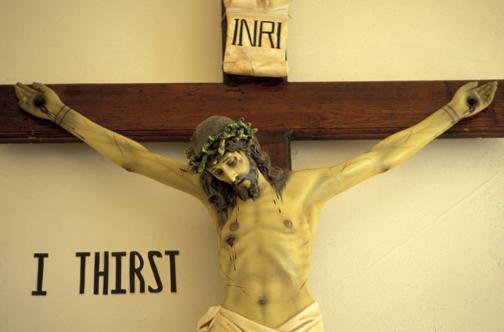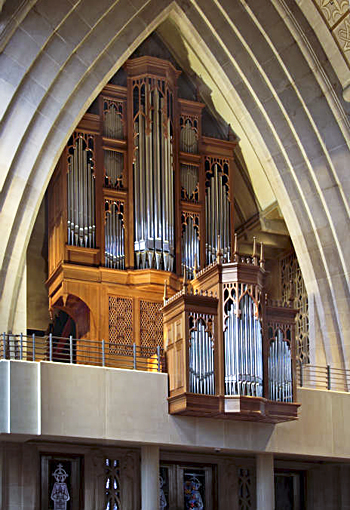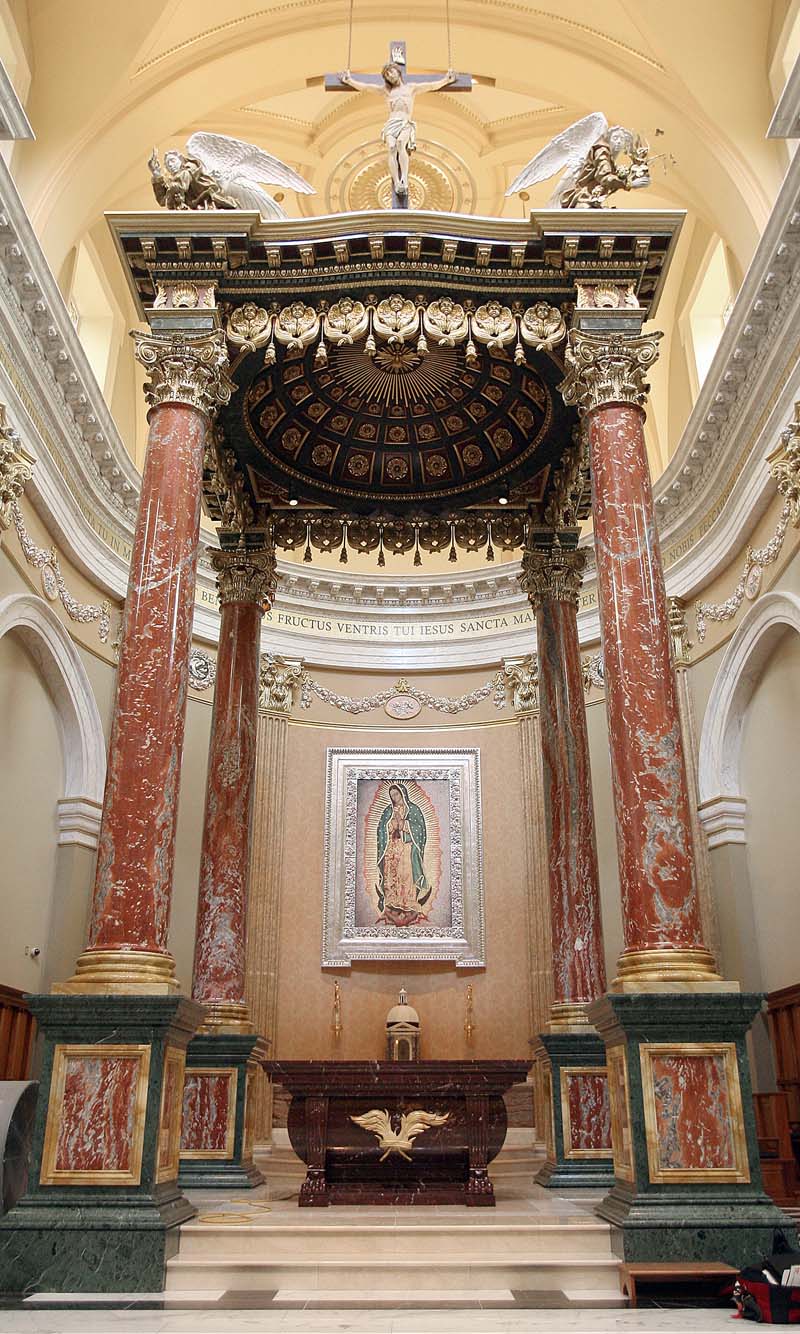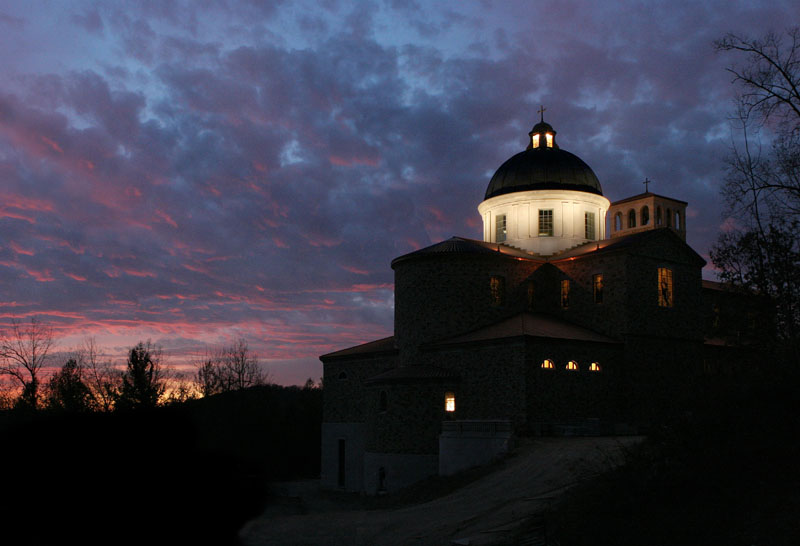In which I finally meet my dear Brother Andre Bessette.
I've been traveling to Boulder a lot for work and my favorite place to attend Mass is at University of Colorado, but their Mass is in the evening and usually our work day doesn't end in time to make it for Mass. Instead, I usually go to Sacred Heart Church in the down town area. The church itself has a really modern feel but once there was an awesome priest who may have been hispanic (anyway he had an accent) who gave a great homily about seeing paradise and knowing that it's real and asking the Holy Spirit to put that conviction in our hearts.
--- 2 ---
In the spring we had a science meeting in Boston and a friend recommended St. Clement Eucharistic Shrine with perpetual adoration!! It's rare that I get to go to Eucharistic adoration on these work trips. My first day there my flight got in way too early so I took a walk to the shrine. I wrote down walking directions but still managed to miss it and get super stressed out. I almost gave up but on the way back saw the right street and gave it another shot. As I stepped into the church, I felt so exhausted that I thought I would just take a peak and return the next day. But the atmosphere was so peaceful that I stayed a while to recharge and happened to catch the recitation of the rosary by the seminarians of the Oblates of the Virgin Mary. The Oblates purchased St. Clement in 1976 and house their seminary here. I was blessed a couple of mornings to attend the chanting of the Divine Office followed by Mass and adoration.
--- 3 ---
On my last day in Boston I decided to visit a different church, called The Mission, with its own beautiful and traditional style, at least architecturally speaking. The inside too is quite beautiful although I was confused when I walked in about fifteen minutes before Mass to find the interior empty save for a man buffing the floors. Coincidentally another newbie walked in behind me and the two of us asked the man about Mass. He sent us down the hall to a chapel where the Redemptorists would celebrate their daily Mass. It seems like a lot of the Boston churches are occupied by Religious Orders! Unfortunately, the Redemtorists say their Divine Office privately in the chapel and let the lay people in for Mass so we had to wait on benches just outside of the chapel. A group of regulars, local older ladies, were discussing how much they love the new pope who is so different from the previous popes and finally setting priorities straight. "Personally, I think we should focus on social justice." So I wasn't surprised when the style of the Mass was rather creative. After Mass the very sweet man next to me asked if I'm a nun, because of my LMC crucifix. All of this made me think, perhaps uncharitably, that this parish probably distributes free copies of the National Catholic Reporter (or as Fr Z calls it, the National Schismatic Reporter).
This summer I attended a science conference in Montreal meaning that I could finally visit St. Joseph's Oratory and the tomb of one of my most favorite Saints, Brother Andre Bessette. I arrived early again so I went straight to the oratory. Unfortunately, it was a gorgeous summer day. I say it was unfortunately because the grounds, which were objectively very beautiful, were covered in indiscreet college couples, screaming and running kids and strange other sights like a man smoking a cigar on the oratory steps. As I went toward the area near Brother Andre's tomb I was caught up in a current of moving people as though it were a busy shopping mall. When Brother Andre was alive he was known as a miracle healer (although he attributed every healing to the intercession of St. Joseph) and the walls of this hall are lined with the crutches that were left by those claiming to have been healed.
Fortunately, Brother Andre's tiny living quarters and shrine behind the oratory was less crowded. The upstairs room was boiling hot and appeared to be without running water. It was also fairly small but not as cramped as I would have expected. When I returned to the parking lot some guys were blaring profane music and I knelt on the sidewalk to pray a Memorare in reparation. Then I went back inside to see the upstairs of the oratory and eventually made my way to a hidden area with a little bench in front of a reliquary containing Brother Andre's heart, which had been removed from his body. I remembered thinking how gruesome and strange it was for them to remove it, especially with the heart and the body now being housed in different parts of the same building. But at this point I felt discouraged and overheated and had a nasty headache and I was extremely grateful to be able to sit in peace and quiet in front of Brother Andre's heart. Eventually a family with children came clanking through, talking in loud voices, but fortunately I had been energized enough to work my way onward to the hotel.
--- 5 ---
The Cathedral-Basilica of Mary Queen of the World (and St. James the Greater) was just across the street from our hotel and less plagued by tourists and poorly behaved students. The Mass was in French but they held Eucharistic adoration afterward starting with the chanting of O Salutaris in Latin. After understanding almost nothing of the Mass I was so excited to be able to sing the familiar Latin hymn with everyone else. It was a moving experience of unity to sing a song in the language of the Church when I couldn't understand the local vernacular, and it gave me a new respect for the Traditional Latin Mass. This Cathedral was the location of Brother Andre's funeral. It contains many beautiful paintings including a depiction of the North American martyrs, also among my favorite Saints!
--- 6 ---
One day we paid to visit the Basilique Notre Dame de Montreal. I thought it was a very weird situation. We didn't just pay a visit. We paid to visit. The website indicated that if I wanted to come to the church to pray I could do so for free but if I just wanted to look then I needed to pay. I wasn't sure just how much praying was required for free admission so I decided to pay like everybody else. At least maybe it supports the community or art restoration. It's a beautiful church, although not in the style I prefer. It does have an amazingly awesome pipe organ!
Sister Nirmala, who succeeded Mother Teresa as the superior general of the Missionaries of Charity, died on June 22. The Sisters at Gift of Hope needed a ride to a memorial Mass at the contemplative house in DC so I was put to work. It was pouring rain to the point that I couldn't see the road so the Sisters decided to pray one of Mother Teresa's quick novenas (i.e. 9 Memorares plus 1 in Thanksgiving). As if on cue the rain stopped and the Sisters managed to lead me to the right place, even without GPS! We were given handouts with the music for the Mass, which are never songs I've ever heard, and the following quote of Sister Nirmala: "Remember who we are. The little ones. The poor ones. Don't despise littleness. Accept it, surrender. These are the channels through which God comes to us."
Eternal rest grant unto her, O Lord, and let the perpetual light shine upon her. May she rest in peace.
For more Quick Takes, visit This Ain't the Lyceum!
























